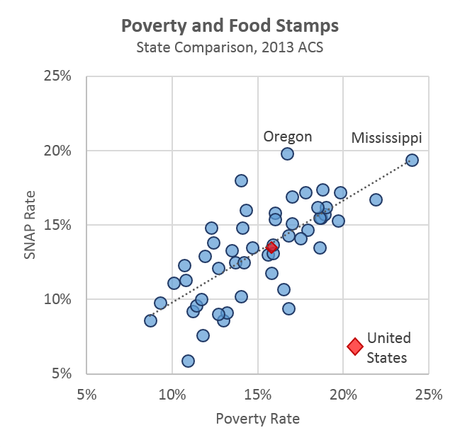Oregon has one of the nation’s highest use of the Supplemental Nutrition Assistance Program (SNAP), commonly known as food stamps, new federal analysis (PDF) shows. That reflects well on Oregon.
It’s true that economic hardship leaves many Americans and Oregonians struggling to put food on the table. Too many workers don’t earn enough and thus need to rely on SNAP to feed their families.
Yet Oregonians’ reliance on SNAP also reflects Oregon’s commitment to helping people struggling to put food on the table.
As Josh Lehner of the Oregon Office of Economic Analysis explains, Oregon is special when it comes to addressing hunger and food insecurity. Oregon has one of the highest rates of SNAP usage as a percent of households while having the 19th highest poverty rate. States with similar poverty rates to Oregon (those in the 16 to 17 percent range) have an average SNAP usage rate of 13.9 percent, compared with Oregon’s 19.8 percent. He illustrates the point with the following chart:
 And what explains Oregon’s exceptional status? Lehner notes, “Oregon is successful in not only enrolling eligible individuals in SNAP but also keeping them enrolled while eligible.” Oregon’s enrollment success is well documented. A recent USDA study (PDF) showed that in 2012 Oregon excelled in enrolling people eligible for SNAP, and tied for fifth best for enrolling the working poor.
And what explains Oregon’s exceptional status? Lehner notes, “Oregon is successful in not only enrolling eligible individuals in SNAP but also keeping them enrolled while eligible.” Oregon’s enrollment success is well documented. A recent USDA study (PDF) showed that in 2012 Oregon excelled in enrolling people eligible for SNAP, and tied for fifth best for enrolling the working poor.
Oregon’s success in enrolling people is the payoff from having an outreach program. Getting that outreach program established was one of the Oregon Center for Public Policy’s first efforts with our colleagues fighting hunger.
High enrollment boosts Oregon’s economy. Federal data shows that about $1.2 billion flowed into Oregon in 2014 from the food stamp program. That’s a large infusion of money into Oregon’s economy that gets spent in communities throughout the state. It’s no wonder business interests like the food stamp program.
Oregon’s commitment to SNAP means that thousands of families are better able to put food on the table. The task now is for policymakers to devote the same kind of commitment to addressing the root cause of hunger: workers who don’t earn enough to escape poverty and achieve economic security.

